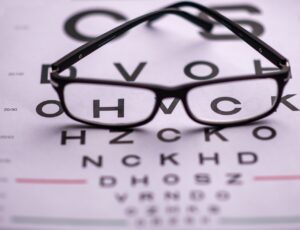Normal functioning of the eye:
The retina is the innermost layer of the eye. It senses light rays coming from the outside world and converts them into signals which are later interpreted by the brain to form a visual image. The caveat to this is that, for proper image formation, most of the light rays entering the eye must focus onto a specific area on the retina called the ‘fovea centralis’. The responsibility of focusing the majority of the light rays onto the fovea centralis lies upon the transparent media present within the eye and in front of the retina. These transparent media focus the light by causing it to bend (or refract) as it passes through them. The parts of the eye which play the biggest role in this phenomenon are:
- The cornea: This is a transparent, hemispherical membrane that lies in the anterior part of the eyeball such that it covers iris and the pupil. The cornea is the structure which is altered during laser surgeries done to correct refractive error. Typically, the refractive power of this structure is +44 dioptres.
- The crystalline lens: This is a transparent, lenticular structure which is present between the iris (colored part of the eye) and the vitreous humour of the eye (a jelly-like substance that fills the inside of the eye as shown above). The crystalline lens of the eye is a flexible structure whose shape can be altered by the action of the ciliary muscles and the zonular fibres through a process known as ‘accommodation’. Generally, the refractive power of the lens varies between +15D to +29D.


To calculate the total refractive power of both the lens and the cornea, we need to add +44D to +15 or +29D. Thus it can be said that the total refractive power of an average eye typically varies between +59D to +70D. If the total refractive power of someone’s eye is between +59D to +70D and the size and shape of their eye normal, then, theoretically, they should have no problems in differentiating two separate points visually I.e. they should be able to form clear visual images of different objects. This phenomenon is known as ‘emmetropia.’ If the eye is not able to focus the light rays onto the fovea centralis, and is thus unable to produce a clear visual image, it is known as ‘ametropia’. Both of these conditions are elaborated further below.
Emmetropia:
When two parallel light rays (i.e. light rays which are coming from a distant object) enter the eye and are focused on the retina without any accomodation of the crystalline lens, it is known as ‘Emmetropia’. This term means that there is no abnormality with either the refractive components, or the size and/or shape of the eye.
Ametropia:
When two parallel light rays (i.e. light rays which are coming from a distant object) enter the eye and are focused not on the retina without any accomodation of the crystalline lens, it is known as ‘Ametropia’. This term denotes an abnormality with either the refractive apparatus, or the size and/or shape of the eye. Types of ametropia include:
References:
https://www.d.umn.edu/~jfitzake/Lectures/DMED/Vision/Optics/Refraction.html
Schiefer, U., Kraus, C., Baumbach, P., Ungewiß, J., & Michels, R. (2016). Refractive errors. Deutsches Arzteblatt international, 113(41), 693–702.
https://doi.org/10.3238/arztebl.2016.0693
http://www.meduniwien.ac.at/eyeexam/pdf-en/eye-exam.pdf
Baird, P. N., Saw, S. M., Lanca, C., Guggenheim, J. A., Smith Iii, E. L., Zhou, X., Matsui, K. O., Wu, P. C., Sankaridurg, P., Chia, A., Rosman, M., Lamoureux, E. L., Man, R., & He, M. (2020). Myopia. Nature reviews. Disease primers, 6(1), 99. https://doi.org/10.1038/s41572-020-00231-4
Disclaimer: The information on this blog is intended to educate and inform and is not a substitute for medical advice, diagnosis or treatment. Prior to acting on the information provided on this blog, you should consult your doctor/healthcare professional.
